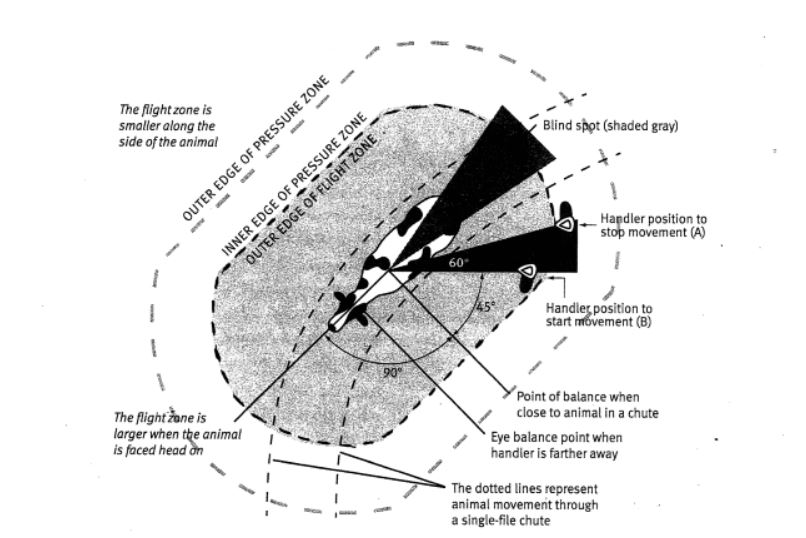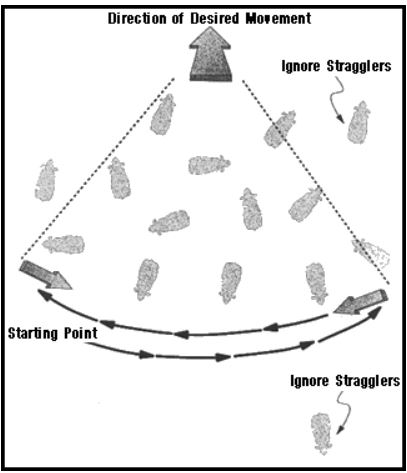Using the Flight Zone to Easily Herd Livestock
Article by: Mallory Meek, Agriculture and Natural Resources Agent
While in college, I had the opportunity to take the class Human Livestock Handling from Dr. Temple Grandin, an animal behavior expert and advocate for autism. If you do not already know who Dr. Grandin is, I highly recommend you watch the movie “Temple Grandin”. In the film, Grandin overcomes prejudice against autism and changes the world's view of how livestock are handled. Because of her autism, she is able to view the animal handling practices from a different perspective and understand animal behavior. It is a great movie for everyone, rancher or not.
While attending that class, I gained knowledge on why and how livestock react in certain situations. One of the variables that affects livestock handling is the Flight Zone. The Flight Zone is the distance at which an animal flees from another animal or human (See diagram 1). The Flight Zone is relative to fear. When someone enters a grazing animal’s Flight Zone, the animal will move away due to not trusting that person. Pets and tame livestock do not move away as they have trust in that person and have no flight zone.
There are various factors that affect the Flight Zone. Those factors include:
- Genetics
- Certain breeds within a certain species have larger flight zones than others.
- Experience with handlers
- Animals that have experience with calm, quiet, and respectful handlers have a smaller flight zone. Those that have experienced loud, quick, and rough handling have a larger flight zone.
- Human contact frequency
- Those that are in contact with humans more often will have a smaller flight zone compared to animals that rarely see humans. For example, dairy cattle that are milked twice a day by a human have a much smaller flight zone that beef cattle that live in a large pasture and only comes in contact with humans a few times a year.
- The angle of approach
- There are variations in the flight zone distance depending on what angle you approach the animal. The animal’s flight zone is larger when the animal is faced head on. The zone is smaller along the sides of the animals (See diagram 1).
Diagram 1:
Using the Flight Zone for easy animal handling:
Knowing and working an animal’s flight zone allows for easy and stress free handling. When you fully understand an animals flight zone, you are able to make moving the animal more efficient. One of the effective methods using the zone is the pressure and release method. When you are herding animals and the animal turns and looks at you to determine if you are a threat or not, you have come to the edge of their outer flight zone. When you get closer and the animal turns away, you have stepped inside the animal’s outer flight zone. You will want to keep a distance from the animal that causes them to walk away from you in a calm and slow manner. If the animal quickly runs and flees, you have stepped too far into their flight zone to cause them panic. When an animal starts to walk quickly, back off a few steps until the animal returns to a slower walking pace.
Point of Balance
To cause an animal to walk forward the handler needs to be behind the point of balance (POB). Where the point of balance is on an animal can depend on how close to the animal you are. When closer, the POB is the shoulder, but when farther away it can become the eye. If you walk in front of the POB it was cause the animal to turn and walk in the opposite direction.
Avoid the Blind Spot
When you stand behind an animal in their blind spot, they are unable to see you. When the animal is unaware of where you are, it will cause that animal fear. This can result in the animal running off or turning around to face you instead of moving in the direction that you wanted the animal to go.
Time to Herd: Zig-Zag Method
Now that you better understand the basics of the flight zone, it’s time to herd your stock. An easy and effective method is the Zig-Zag Method (Diagram 2). The handler moves in a zig-zag pattern behind the animals without moving forward. The movement should not exceed the size of a quarter circle. If you curve around too far, you will exceed some animal’s POB causing them to walk in the opposite direction of where you want them to go. The movement should be continuous. If you stop or slow down too much, you may be in one animals blind spot for too long causing them to flee. If you have a straggler, do not chase after it. Herd animals like to be in herds, so they will eventually seek the safety of moving back with the group. Once the animals form a loose bunch, you can start moving the herd forward. Keep the continuous zig zag movement but apply slight pressure to the animal’s flight zone to cause them to move forward. Use the pressure and release method to control the speed of the animals’ movement (Grandin). Watch this video here for a visual on what this looks like in a pasture. https://www.youtube.com/watch?time_continue=25&v=ZZyFRRn--jk&feature=emb_title
Diagram 2:
Information and Diagrams were summarized from the book: Human Livestock Handling-Understanding Livestock and Building Facilities for Healthier Animals by Dr. Temple Grandin with Mark Deesing.
More information on Dr. Temple Grandin's methods of animal handling visit:
Citation:
Grandin, Temple. “Chapter Three: From Pasture To Pen.” Human Livestock Handling, Storey Publishing, 2008, pp. 32–43.


